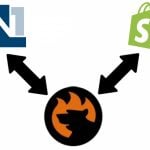The Ultimate Guide To Shopify Integrations
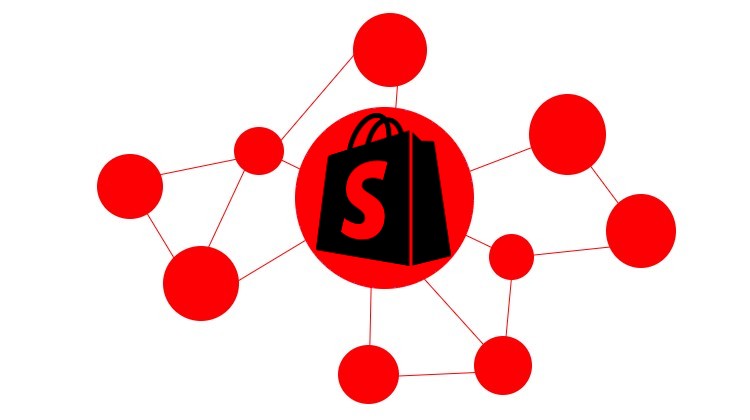
Let’s talk about Shopify integrations. Most people know Shopify as a fully independent e-commerce platform. However, its default functionality is not always enough to satisfy specific business demands. If it happens so, merchants need to integrate Shopify with third-party systems. Below, we’d like to introduce you to the core types of Shopify integrations. We discuss native, third-party, iPaaS, and custom integrations. You will learn their distinctive features, advantages, and disadvantages. Also, we highlight the most popular Shopify integrations including platforms such as SAP Business One, Quickbooks, Amazon, Hubspot, WordPress, and Salesforce.

If you want to integrate any system with Shopify – write to us!
Table of contents
Different Types of Shopify Integrations
Shopify features a robust app store with over 4,000 apps and integrations. They enable businesses to leverage marketing tools, accounting software, customer care platforms, and other features. Although many of these apps and integrations are associated with third-party developers, Shopify also provides several native solutions.
Native Shopify integrations are intended to be simple to use and set up, with straightforward installation and configuration procedures. They are usually designed to be fully integrated with the Shopify platform, allowing for seamless operation right after a few minutes of tweaking. By default, Shopify works with a multitude of payment gateways, including PayPal, Stripe, and Square, allowing businesses to accept a wide range of payment methods securely. The platform also interfaces with key shipping carriers like USPS, UPS, and DHL, making it simple for merchants to manage delivery duties.
You may need to integrate Shopify with existing tools to increase productivity, sell your products more efficiently, create better customer collaboration, etc. The good news is that there is no need to leave the ecosystem because the platform’s marketplace contains everything your business may require. At the same time, iPaaS and bespoke connectors are available if the marketplace apps don’t cover your needs. These different ways to manage Shopify integrations are described below.
Native Integrations

Shopify POS
Native Shopify integrations are those that Shopify has created for its users and made them fully connected with the platform, enabling smooth data synchronization and operation. Here are some examples of native Shopify integrations:
- Shopify Payments: Shopify’s payment gateways allow businesses to take credit card payments directly through their web store.
- Shopify Shipping: Shopify provides external shipping and fulfillment solutions built into the platform to allow businesses to print shipping labels and track shipments.
- Shopify POS: A point-of-sale system offered by Shopify authorizes businesses to process in-person transactions using a smartphone or tablet.
- Shopify Email: Shopify’s email marketing platform provides the ability to create and send targeted email campaigns to their customers.
- Shopify Capital: A financing service offered by Shopify provides businesses with access to capital to help them grow.
Native Shopify integrations are typically included with a Shopify subscription, and they are designed to be easy to use and set up. They can provide entrepreneurs with access to a wide range of tools and features fully integrated with their websites. If you need to streamline operations and focus on growing your business, native Shopify integrations are right here.
Third-party Integrations

Shopify Xero Bridge by Parex
Many third-party Shopify integrations, in turn, are also designed to be easy to use and set up. They provide businesses with access to a wider range of additional functionality. For instance, the following third-party instruments are available for Shopify users:
- Marketing and advertising tools: Such instruments allow businesses to create and manage marketing campaigns, analyze traffic, and optimize their store for search engines. For instance, you may use instead of Shopify’s native email marketing solution starting from $13 monthly.
- Customer service and support tools: Apps that provide businesses with customer service and support functionality include all possible live chat, email support, and customer feedback tools. You can easily integrate your Shopify website with a chat by or .
- Accounting and financial tools: Shopify App Store offers numerous tools designed to manage finances and accounting, including invoicing, expense tracking, and inventory management. Some popular integrations include or .
- Social media and email marketing tools: Several third-party apps on the Shopify App Store allow businesses to connect their e-commerce websites to corresponding social media accounts and send targeted email campaigns to customers. You can leverage third-party Shopify integrations with or .
iPaaS Integrations
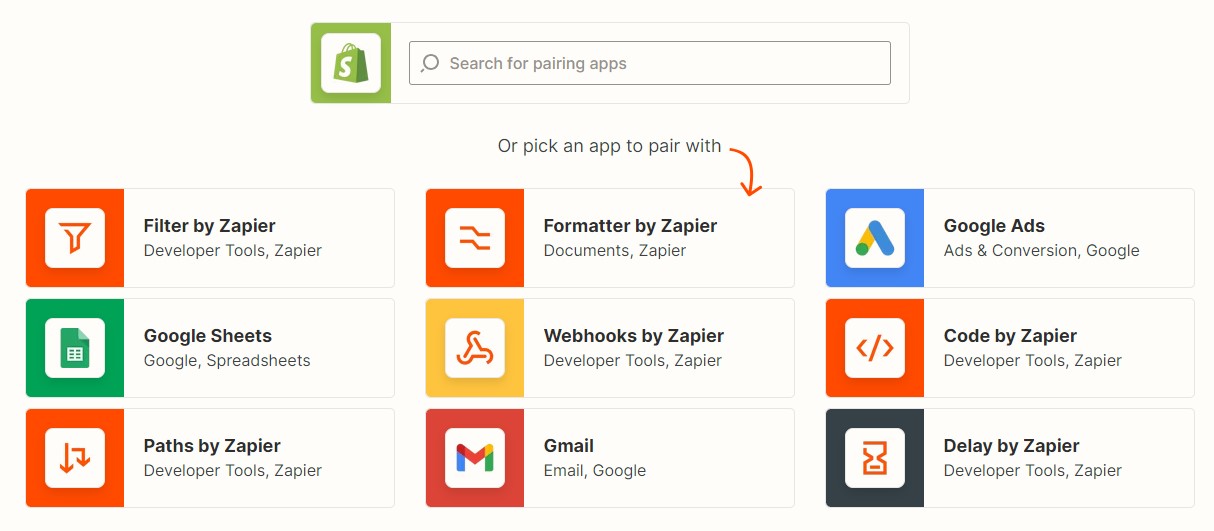
Shopify iPaaS integrations with Zapier
With Shopify iPaaS integrations, you can connect your e-commerce website to other software applications and platforms differently. Here are three distinctive features of iPaaS integrations:
- No Installation: You don’t need to install third-party apps on your website. It is only necessary to grant an iPaaS system with access to your Shopify store and a system you want to connect.
- Easy Configuration: Establishing a simple Shopify integration with iPaaS requires only a few clicks.
- Automation: The ability to automate numerous business operations, such as adjusting product inventory levels or syncing customer data, is one of the primary distinctive features and benefits of Shopify iPaaS connections. They save time and eliminate the need for manual data entry.
Let’s look at several examples of Shopify iPaaS integrations. Although the platform offers built-in inventory management capabilities, you may use iPaaS integrations to connect Shopify to third-party inventory management software. Integration with inventory management systems, such as Zoho inventory, allows you to update your product inventory levels automatically based on real-time data from the integrated systems.
The built-in order management capabilities can also be replaced with more robust options due to iPaaS systems. Integration with order management systems like NetSuite, for instance, allows you to automatically update order status, tracking information, and other details, combining data from Shopify and other channels.
iPaaS integrations with accounting software, in turn, allow you to sync financial data between your e-commerce website and accounting systems such as QuickBooks. Shopify integrations with CRM systems like Salesforce enable automated customer data sync between Shopify and the connected platform. You can manage customer relationships more effectively without spending time on data synchronization.
Overall, Shopify iPaaS integrations provide numerous benefits, including increased efficiency, improved data accuracy, and cost savings. Below, you can see a few examples of iPaaS platforms suitable for Shopify:
- Zapier: This is a popular iPaaS platform that allows you to connect your Shopify store to over 2,000 different apps and platforms, including Google Sheets, Mailchimp, and Salesforce.
- Workato: With the help of this instrument, you can integrate your Shopify store into a wide range of apps and tools, including QuickBooks, Xero, and Slack.
- Integromat: This iPaaS platform lets you create automated workflows, connecting your e-commerce website with other systems, such as Google Calendar and Trello.
- Skyvia: With this iPaaS system, it is possible to connect Shopify stores to such cloud-based apps as Salesforce and Microsoft Dynamics.
- Jitterbit: This iPaaS software enables Shopify integrations with a wide range of tools like NetSuite, Zendesk, and ServiceNow.
These are just a few examples of the many iPaaS platforms that allow businesses to connect their Shopify store to other systems. Usually, they let merchants establish connections that incorporate the following actions and entities:
| Entity | Description | Supported actions |
| Customer | A customer is someone who purchases goods and services on your storefront. |
|
| Order | An order is a collection of goods or services that a buyer adds to their shopping cart and pays for at the checkout. |
|
| Product | A product is a physical or digital item or service sold on your website. |
|
Custom Integrations

Custom Shopify integrations are developed specifically for a business’s unique needs and requirements. They can connect businesses with other systems when the existing solutions cannot cope with specific requirements. These integrations can be developed using APIs (Application Programming Interfaces) or other integration technologies.
No matter who creates custom integrations – Shopify or a third party – they are always unique and suitable for specific conditions only. Some examples of custom Shopify integrations include:
- Integration with a custom-built inventory management system.
- Integration with a proprietary CRM system.
- Integration with a custom-built order management system.
- Integration with a custom-built accounting system.
- Integration with a proprietary loyalty program.
Our team can create a custom Shopify integration on top of our . Just let us know your specific data transfer needs, and we will figure out the best possible solution. Contact us to find out more about the Shopify integration possibilities our team provides.
Shopify & Its Most Popular Integrations
Below, we explore the most popular Shopify integrations: SAP Business One, Quickbooks, Amazon, Hubspot, WordPress, and Salesforce.
SAP Business One
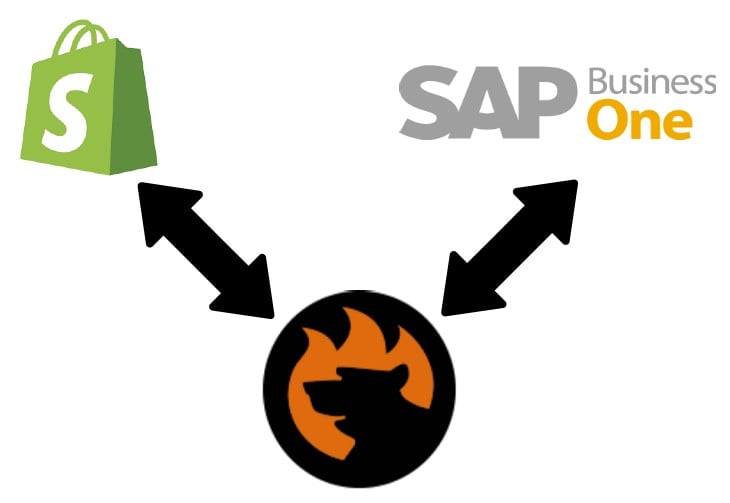
SAP Business One is an enterprise resource planning application designed for small and medium-sized businesses. You can easily sync it with your e-commerce website with the help of the Shopify SAP Business One Integration connector. The platform covers multiple areas from accounting and financials, purchasing, inventory, sales, and customer relationships to reporting and analytics.
With the Firebear team, you can get a Shopify SAP integration with the following features:
- Real-time synchronization of customer and order data;
- Manual re-syncing of customer data;
- Powerful mapping;
- Detailed sync history;
- Fully-featured debugging instruments;
- CLI controls over the integration;
- Scheduled pipelines;
- Support for UDFs, custom fields, and properties;
- Support for tracking data.
Contact us using the link below to learn more about the Shopify SAP integration and other crucial business connections:
We also work on a connector for Shopify NetSuite Integration and Shopify Microsoft Dynamics Integration.
Quickbooks
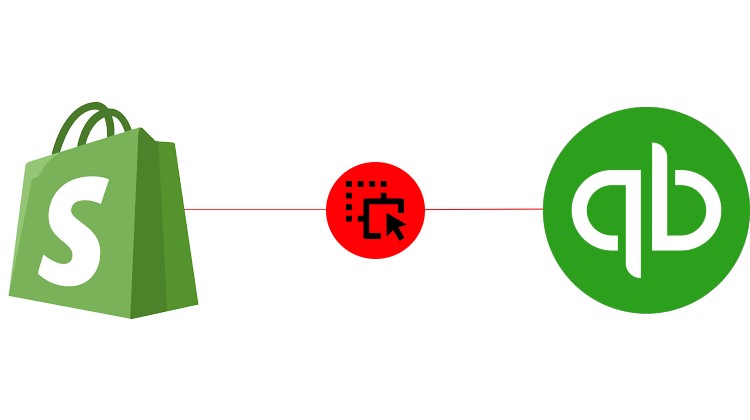
QuickBooks is a financial software program that assists small and medium-sized enterprises with managing financial data such as invoicing, billing, costs, and payroll. It includes a variety of features and tools to help with financial management:
- Invoicing and billing: Create and send invoices and bills to your customers. Track and manage unpaid invoices.
- Expense tracking: Track and categorize your expenses, including employee expenses, travel expenses, and business-related expenses.
- Payroll: Use payroll tools, including payroll tax calculations, employee time tracking, and employee payroll tax forms.
- Financial reporting: Leverage financial reports, including profit and loss statements, balance sheets, and cash flow statements.
- Inventory management: Track inventory levels, set reorder points, and generate purchase orders.
Wanna know more about the Shopify integration with Quickbooks? Drop us a message.
Amazon
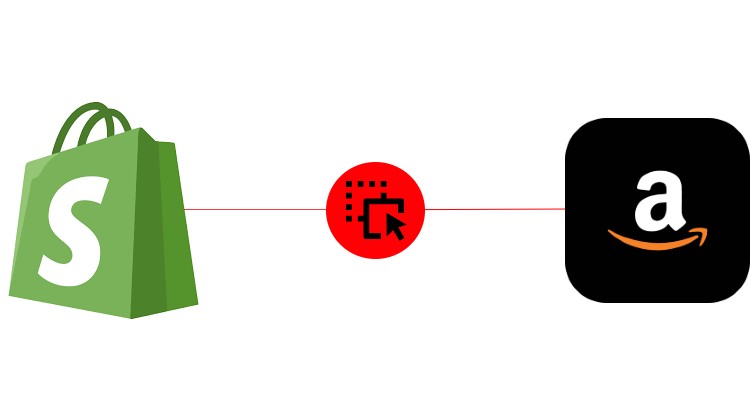
Amazon Marketplace is an online platform where third-party retailers can sell their products. It enables businesses and individuals to set up an online store, connecting to millions of Amazon customers via different categories, including electronics, home and kitchen, fashion, health, etc.
Amazon Marketplace provides a variety of tools to assist sellers in managing their online business. With the Shopify Amazon integration, you can leverage the following features:
- Product listing: List your Shopify products on Amazon, including product descriptions, images, and pricing.
- Order management: Manage your Amazon orders in the Shopify admin.
- Inventory management: Sync their inventory levels between Shopify and Amazon.
- Fulfillment: Fulfill orders on your side or use Amazon’s fulfillment service to handle shipping and delivery.
Wanna know more about the Shopify integration with Amazon? Drop us a message.
Hubspot

HubSpot is a CRM platform that helps businesses attract, engage, and delight customers with different marketing, sales, customer service, and analytics tools. As for the HubSpot Shopify integration, it can dramatically extend your website’s functionality due to data synchronization and marketing automation. Some features of this integration include:
- Customer data syncing: Sync customer data between HubSpot and Shopify, including customer names, email addresses, and purchase history.
- Order data syncing: Sync order data between the two systems, including order details, tracking information, and customer data.
- Product data syncing: Sync product data between HubSpot and Shopify, including product names, descriptions, and pricing.
- Marketing automation: Use marketing automation tools to create targeted campaigns and send personalized email messages to your Shopify customers.
Wanna know more about the Shopify integration with HubSpot? Drop us a message.
WordPress
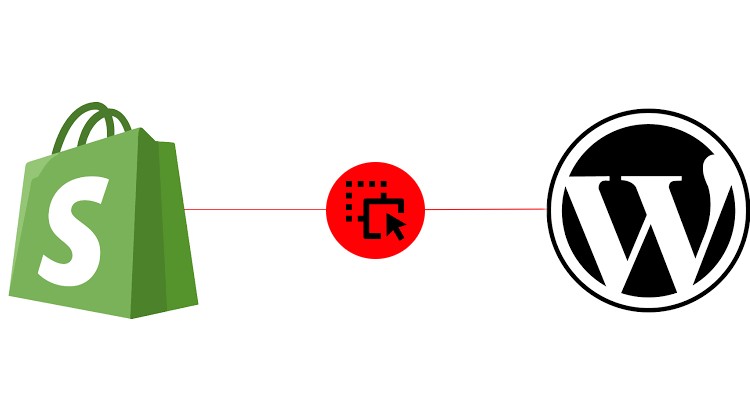
WordPress is an open-source content management system known for its user-friendliness and flexibility. It is used by millions of people worldwide to create and manage websites, including blogs, e-commerce stores, business websites, etc.
Some features of the Shopify WordPress integration include:
- Product display: Display your Shopify products on the connected WordPress website.
- Checkout: Let customers purchase products directly from the WordPress website and let the Shopify WordPress integration handle the checkout process.
- Inventory management: Sync inventory levels between Shopify and WordPress.
- Order management: Manage your orders in the most convenient place.
Wanna know more about the Shopify integration with WordPress? Drop us a message.
Salesforce
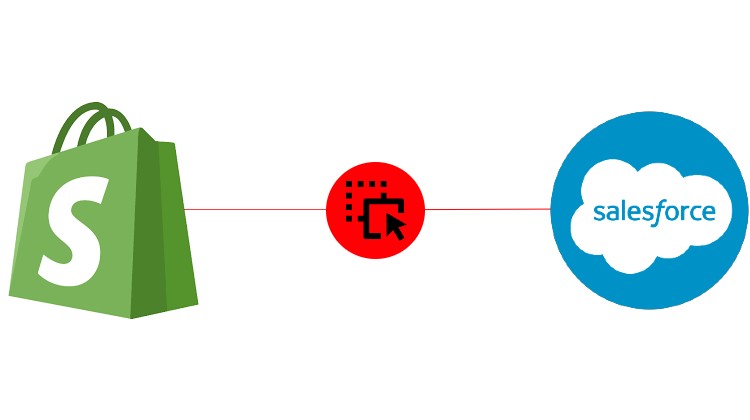
Salesforce is another CRM platform that helps businesses manage and grow their customer relationships. It is a cloud-based system designed to attract, engage, and retain customers. The Shopify integration with Salesforce, in turn, allows store owners to connect their e-commerce websites to Salesforce to sync data between the two platforms.
Some features of the Shopify integration with Salesforce include:
- Customer data syncing: Sync customer data between the two systems, including customer names, email addresses, and purchase history.
- Order data syncing: Sync order data between Shopify and Salesforce, including order details, tracking information, and customer data.
- Product data syncing: Sync product data between the two systems, including product names, descriptions, and pricing.
- Marketing automation: Use Salesforce’s marketing automation tools to build targeted campaigns and send personalized messages to your buyers.
Wanna know more about the Shopify integration with WordPress? Drop us a message.
Shopify Integrations FAQ
How do Shopify integrations work?
Shopify integrations can be established in several ways. Firstly, you deal with native integrations that are available by default, like integrations with payment gateways and shipping providers. Secondly, you can rely on third-party apps that can be used to add new features and functions to your Shopify store. In addition to that, iPaaS systems can dramatically extend these opportunities. And if these three options are not enough, you can create a custom connector.
What is API integration in Shopify?
Shopify API integration is a process of connecting to your e-commerce website using Shopify’s application programming interface. Usually, it lets you retrieve and synchronize the information on customers, products, categories, orders, abandoned carts, prices, etc.
Is Shopify API free?
Although Shopify API is free to use, it is associated with limitations. For instance, you can only use the Shopify API to create and manage Shopify stores but you may not get access to the product or order creation.
Can I integrate Shopify into my website?
You can use the Shopify Buy Button to fully integrate Shopify’s ecommerce tools with any website. No matter whether it is built on WordPress, Squarespace, Wix, or other platforms.
Can Amazon be integrated with Shopify?
You can connect Shopify and Amazon via third-party extensions, iPaaS platforms, or custom connectors. Choose a tool that better suits your needs.
Conclusions
Shopify is a popular e-commerce platform that offers a variety of integrations both built-in and those that can be added as your business grows. Shopify integrations with various external tools can help you save time and resources by automating diverse tasks and processes, such as tracking inventory, processing orders, and sending shipping notifications. It can also help access new markets and reach a wider audience by selling products on multiple channels, including your Shopify website, social media platforms, and online marketplaces like Amazon and eBay.
If you want to integrate any system with Shopify – write to us!
However, if you want to migrate from Shopify, you can also do that with Firebear. Learn how to cancel a Shopify subscription.



